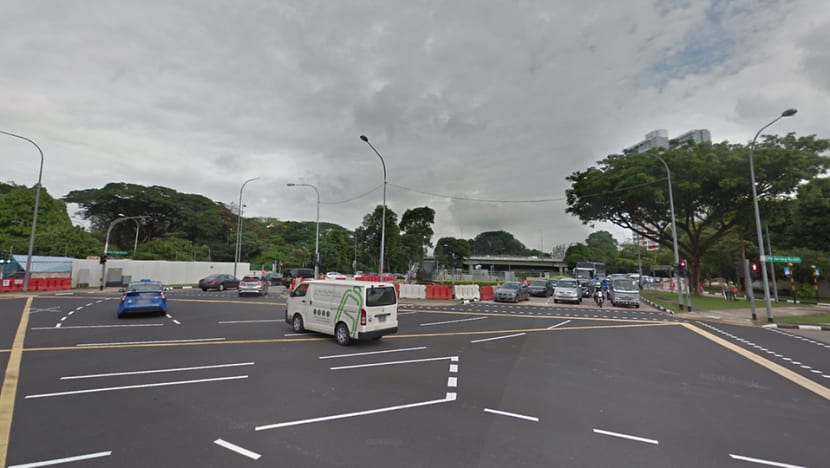Scrap discretionary right turns at all junctions soon, MPs urge as Road Traffic Act amendments passed

The junction of Jalan Anak Bukit and Jalan Jurong Kechil where a fatal accident involving a car making a discretionary right turn took place. (Image: Google Street View)
SINGAPORE: Members of Parliament (MPs) on Monday (Jul 8) urged authorities to speed up the removal of discretionary right turns at all junctions, arguing that they have led to numerous fatal accidents and are “fundamentally problematic”.
This comes as Parliament passed amendments to the Road Traffic Act, which introduced harsher penalties for dangerous and careless driving as well as driving under the influence of alcohol or drugs.
For dangerous driving causing death, first-time offenders will be jailed at least two years while repeat offenders will be jailed at least four years.
For driving under the influence, offenders face double the current penalties, including a lifetime ban for repeat offenders.
With the amendments, first-time offenders face up to a year in jail, or a fine ranging from S$2,000 to S$10,000 and they can be disqualified from driving for at least two years. For the second offence, they face up to two years in jail and a fine of between S$5,000 and S$20,000, as well as a ban from driving for at least five years.
READ: New mandatory minimum jail sentences among proposed amendments to Road Traffic Act
While MPs welcomed the changes on Monday, they pressed for a speedier and more thorough intervention on discretionary right turns, which allow drivers to turn right on green when they deem it to be safe.
Last April, two people were killed after vehicle collisions at the intersections of Commonwealth Avenue West and Clementi Road, as well as Upper Bukit Timah Road and Jalan Anak Bukit. In both cases, one of the vehicles in either accident made a discretionary right turn.
Following that, the Land Transport Authority (LTA) said it would remove discretionary right turns at most traffic junctions by 2023, meaning motorists can only turn right on a green arrow.
But Nominated MP Lim Sun Sun urged the LTA to shorten this timeline to prevent more accidents and fatalities, as she detailed her own experience getting hit by a bus that was making a discretionary right turn.
Last month, she was crossing the junction of Upper Changi Road East and Somapah Road with the green man on when a “big, lumbering double decker” collided into her. She hit her head against the road and landed on her back.
When she raised the incident to colleagues and students, many of them immediately raised the issue of discretionary right turns and the “near misses” they witnessed at the same junction.
“Discretionary right turn junctions are fundamentally problematic,” Ms Lim said.
“Drivers wait anxiously in the right turn box and make a dash for it when they note the absence of oncoming traffic, overlooking the fact that there could also be pedestrians crossing at the same time.”
READ: LTA to review traffic light scheme at right-turn junctions following fatal accidents
Likewise, Tanjong Pagar GRC MP Joan Pereira urged authorities to expedite the process of introducing red-amber-green (RAG) arrows, adding that she wanted this to be implemented at not most, but all, junctions.
“I think it is important all junctions should have RAG signaling, and when pedestrians may cross, no vehicles should be permitted to turn,” she said.
“These signals should be consistent to reduce confusion among motorists who now encounter different signaling at different junctions.”
Fellow Tanjong Pagar GRC MP Melvin Yong agreed, adding that a full implementation would “go a long way in making our roads a safer place”.
READ: Taxi driver charged with causing death of NUS undergrad Kathy Ong
MP for Holland-Bukit Timah GRC Christopher de Souza also asked if it was possible to remove situations where a car turns into a road on a green light while people are crossing on a green man.
“This will make the roads safer for drivers and pedestrians, if indeed this is possible and the traffic flow allows for such permutations,” he said.
“The presence of a green light and a simultaneous green man can cause confusion and accidents can happen.”
In response to these suggestions, Senior Parliamentary Secretary for Home Affairs Sun Xueling said: “MHA will consider these suggestions with the relevant agencies for future reviews.”
CALIBRATE FINES BASED ON INCOME AND WEALTH
Meanwhile, NMP Walter Theseira also raised the possibility of calculating fines for traffic offences based on income levels, to keep the “deterrent effect” of fines while being mindful of the impact on vocational drivers.
“A fine that is large enough to be meaningful and appropriate to punish the average motorist may be too large for lower income motorists and too small for the richest motorists,” he said.
“Fines don’t work if they are so large that people can’t pay, and fines also don’t work if they are not meaningful deterrents.”
He suggested calibrating fines based on the open market value of the offender’s vehicle for privately owned passenger cars, as he found it “reasonable to presume” that the driver of a luxury car would be able to pay a larger fine compared to the driver of a cheaper vehicle.
Responding to Dr Theseira’s suggestion, Ms Sun acknowledged the progressive fine system in place in other countries, such as the income-based system in Finland and the discontinued trials in the United Kingdom.
“MHA will study the suitability and impact of implementing a similar system,” she said.
















